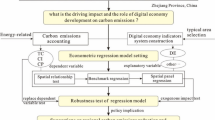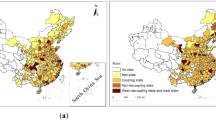Abstract
This paper explores the spatial impact effects and spatio-temporal heterogeneity of the digital economy on urban carbon emissions (CO2). Specifically, firstly, the Digital Economy Index (DEI) system of 285 cities in China was constructed and the Global Principal Component Analysis (GPCA) was applied to evaluate the digital economy level of Chinese cities. Based on spatial correlation and spatial heterogeneity, the paper explores the global spatial impact and spatio-temporal heterogeneity of the impact of digital economy on CO2 using spatial Durbin model (SDM) and geographic time-weighted regression (GTWR), respectively. And the mechanism variables are used to further demonstrate the mechanism effect and nonlinear characteristics of the impact of digital economy on CO2. The findings indicate that (1) the advancement of the digital economy is beneficial for achieving carbon abatement goals, and the impact of the digital economy on CO2 mitigation remains stable across several robustness tests. (2) The spatial spillover effect of the digital economy on the impact of carbon reduction is not significant. And there is significant temporal and spatial heterogeneity in the impact of the digital economy on carbon emissions. (3) According to the mechanism analysis, the digital economy reduces carbon emissions by encouraging the development of green technologies and promoting the modernization of industrial structures. And there are non-linear characteristics of this effect. This study concludes that the digital economy can support China’s goal of achieving “carbon peak and carbon neutrality.” However, it is important to consider the differences in urban development over time and space. Leveraging the city’s strengths to develop a digital economy in a unique way that will help achieve China's carbon reduction goals.




Similar content being viewed by others
Data availability
All the data and materials were freely available in the statistical earbooks.
References
Bai F, Huang Y, Shang M, Ahmad M (2022) Modeling the impact of digital economy on urban environmental pollution: empirical evidence from 277 prefecture-level cities in China. Front Environ Sci 6. https://doi.org/10.3389/fenvs.2022.991022
Brent R, Steven L (1999) GDP and the digital economy: keeping up with the changes. MIT, Cambridge, MASS
Bhujabal P, Sethi N, Padhan PC (2021) ICT, foreign direct investment and environmental pollution in major Asia Pacific countries. Environ Sci Pollut Res 28:42649–42669. https://doi.org/10.1007/s11356-021-13619-w
Cai A, Zheng S, Cai L, Yang H, Comite U (2021) How does green technology innovation affect carbon emissions? A spatial econometric analysis of China’s provincial panel data. Front Environ Sci 9. https://doi.org/10.3389/fenvs.2021.813811
Chen S, Ding D, Shi G, Chen G (2022) Digital economy, industrial structure, and carbon emissions: an empirical study based on a provincial panel data set from China. Chin J Popul Resour Environ 20:316–323. https://doi.org/10.1016/j.cjpre.2022.11.002
Cheng Y, Zhou X, Li Y (2023) The effect of digital transformation on real economy enterprises’ total factor productivity. Int Rev Econ Finance 85:488–501. https://doi.org/10.1016/j.iref.2023.02.007
Dagum C (1997) A new approach to the decomposition of the Gini income inequality ratio. Empir Econ 22:515–531. https://doi.org/10.1007/BF01205777
Dong F, Hu M, Gao Y, Liu Y, Zhu J, Pan Y (2022) How does digital economy affect carbon emissions? Evidence from global 60 countries. Sci Total Environ 852. https://doi.org/10.1016/j.scitotenv.2022.158401
Gomber P, Kauffman R, Parker C, Weber B (2018) On the Fintech revolution: interpreting the forces of innovation, disruption, and transformation in financial services. J Manag Inf Syst 35:220–265. https://doi.org/10.1080/07421222.2018.1440766
Guo S, Ma H (2022) Can urban digitalization significantly improve carbon emission efficiency? Evidence from 282 cities in China. Res Square Platform LLC. https://doi.org/10.21203/rs.3.rs-2035590/v1
Hansen B (1999) Threshold effects in non-dynamic panels: estimation, testing, and inference. J Econom 93:345–368. https://doi.org/10.1016/S0304-4076(99)00025-1
Huang B, Wu B, Barry M (2010) Geographically and temporally weighted regression for modeling spatio-temporal variation in house prices. Int J Geogr Inf Sci 24:383–401. https://doi.org/10.1080/13658810802672469
Kuik O, Gerlagh R (2003) Trade liberalization and carbon leakage. Energy J 24:97–120. https://doi.org/10.5547/ISSN0195-6574-EJ-VOL24-NO3-4
Lange S, Santarius T, Pohl J (2020) Digitalization and energy consumption: does ICT reduce energy demand? Ecol Econ 176:50–73. https://doi.org/10.1016/j.ecolecon.2020.106760
Li G, Zhang R, Feng S, Wang Y (2022) Digital finance and sustainable development: evidence from environmental inequality in China. Bus Strategy Environ. https://doi.org/10.1002/bse.3105
Li J, Chen L, Chen Y, He J (2021) Digital economy, technological innovation, and green economic efficiency-empirical evidence from 277 cities in China. MDE Manage Decis Econ 43:616–629. https://doi.org/10.1002/mde.3406
Li X, Wang H, Yang C (2023) Driving mechanism of digital economy based on regulation algorithm for development of low-carbon industries. Sustain Energy Technol Assess 55. https://doi.org/10.1016/j.seta.2022.102909
Li Z, Wang J (2022) The dynamic impact of digital economy on carbon emission reduction: evidence city-level empirical data in China. J Clean Prod 351. https://doi.org/10.1016/j.jclepro.2022.131570
Liang L, Li Y (2023) How does government support promote digital economy development in China? The mediating role of regional innovation ecosystem resilience. Technol Forecast Soc Change 188. https://doi.org/10.1016/j.techfore.2023.122328
Liu J, Yang Y, Zhang S (2020) Research on the Measurement and driving factors of China’s digital economy. Shanghai Econ Rev 06:81–96. https://doi.org/10.19626/j.cnki.cn31-1163/f.2020.06.008
Ma D, Zhu Q (2022) Innovation in emerging economies: research on the digital economy driving high-quality green development. J Bus Res 145:801–813. https://doi.org/10.1016/j.jbusres.2022.03.041
Ma G, Qin J, Zhang Y (2023) Does the carbon emissions trading system reduce carbon emissions by promoting two-way FDI in developing countries? Evidence from Chinese listed companies and cities. Energy Econ 120. https://doi.org/10.1016/j.eneco.2023.106581
Manne A, Richels RG (1999) The Kyoto Protocol: a cost-effective strategy for meeting environmental objectives? Energy J 20:1–23. https://doi.org/10.1007/978-94-015-9484-4_3
May G, Stahl B, Taisch M, Kiritsis D (2017) Energy management in manufacturing: from literature review to a conceptual framework. J Clean Prod 167:1464–1489. https://doi.org/10.1016/j.jclepro.2016.10.191
Pan X, Wei Z, Han B, Shahbaz M (2021) The heterogeneous impacts of interregional green technology spillover on energy intensity in China. Energy Econ 96. https://doi.org/10.1016/j.eneco.2021.105133
Salahuddin M, Alam K (2015) Internet usage, electricity consumption and economic growth in Australia: a time series evidence. Telemat Inform 32:862–878. https://doi.org/10.1016/j.tele.2015.04.011
Schiederig T, Tietze F, Herstatt C (2012) Green innovation in technology and innovation management an exploratory literature review. R&D Manag 42. https://doi.org/10.1111/j.1467-9310.2011.00672.x
Tapscott D (1996) The digital economy: promise and peril in the age of networked intelligence. McGrawHill, New York
Turcan R, Juho A (2014) What happens to international new ventures beyond start-up: an exploratory study. J Int Entrepreneurship 12:129–145. https://doi.org/10.1155/2022/6366061
van Ark B (2016) The productivity paradox of the new digital economy. Int Productivity Monitor Centre Stud Living Standards 31:3–18 https://ideas.repec.org/a/sls/ipmsls/v31y20161.html
Wang H, Guo J (2022) Impacts of digital inclusive finance on CO2 emissions from a spatial perspective: Evidence from 272 cities in China. J Clean Prod 355. https://doi.org/10.1016/j.jclepro.2022.131618
Wang J, Dong K, Dong X, Taghizadeh-Hesary F (2022) Assessing the digital economy and its carbon-mitigation effects: the case of China. Energy Econ 113. https://doi.org/10.1016/j.eneco.2022.106198
Wang J, Luo X, Zhu J (2022a) Does the digital economy contribute to carbon emissions reduction? A city-level spatial analysis in China. Chin J Popul Resour Environ 20:105–114. https://doi.org/10.1016/j.cjpre.2022.06.001
Wang J, Wang B, Dong K, Dong X (2022b) How does the digital economy improve high-quality energy development? The case of China. Technol Forecast Soc Change 184. https://doi.org/10.1016/j.techfore.2022.121960
Wang K, Wu M, Sun Y, Shi X, Sun A, Zhang P (2019) Resource abundance, industrial structure, and regional carbon emissions efficiency in China. Resour Policy 60:203–214. https://doi.org/10.1016/j.resourpol.2019.01.001
Xing Z, Huang J, Wang J (2022) How to coordinate China’s regional low-carbon digital economy with economic and social development: a composite system synergy perspective. Res Square Platform LLC. https://doi.org/10.21203/rs.3.rs-1968555/v1
Xv W, Zhou J, Liu C (2022) The impact of digital economy on urban carbon emissions: based on the analysis of spatial effects. Geograph Res 41:111–129. https://doi.org/10.11821/dlyj020210459
Yi M, Liu Y, Sheng MS, Wen L (2022) Effects of digital economy on carbon emission reduction: new evidence from China. Energy Policy 171. https://doi.org/10.1016/j.enpol.2022.113271
Yuan B, Li C, Yin H, Zeng M (2022) Green innovation and China’s CO2 emissions-the moderating effect of institution quality. J Environ Plan Manag 65:877–906. https://doi.org/10.1080/09640568.2021.1915260
Zhang J, Lyu Y, Li Y, Geng Y (2022c) Digital economy: an innovation driving factor for low-carbon development. Environ Impact Assess Rev 96. https://doi.org/10.1016/j.eiar.2022.106821
Zhang L, Mu R, Zhan Y, Yu J, Liu L, Yu Y, Zhang J (2022b) Digital economy, energy effificiency, and carbon emissions: evidence from provincial panel data in China. Sci Total Environ 852. https://doi.org/10.1016/j.scitotenv.2022.158403
Zhang W, Liu X, Wang D, Zhou J (2022a) Digital economy and carbon emission performance: Evidence at China’s city level. Energy Policy 165. https://doi.org/10.1016/j.enpol.2022.112927
Zhong Y, Mao W (2020) Spatial differentiation of digital economy and its influencing factors in the Yangtze River Economic Belt. J Chongqing Univ (Soc Sci Ed) 1:19–30. https://doi.org/10.11835/j.issn.1008-5831.jg.2019.05.002
Zhou K, Yang S, Shao Z (2016) Energy Internet: the business perspective. Appl Energy 178:212–222. https://doi.org/10.1016/j.apenergy.2016.06.052
Funding
This work was supported by the Major Program of the National Social Science Foundation of China (21&ZD106)
Author information
Authors and Affiliations
Contributions
Yixin Sun: writing—original draft; Linzhu Wang: writing—review and editing; Deyi Xv: review and editing
Corresponding author
Ethics declarations
Ethics approval
Not applicable, because this article does not contain any studies with human or animal subjects.
Consent to participate
Not applicable
Consent for publication
Not applicable
Competing interests
The authors declare no competing interests.
Additional information
Responsible Editor: Ilhan Ozturk
Publisher’s note
Springer Nature remains neutral with regard to jurisdictional claims in published maps and institutional affiliations.
Appendices
Appendix 1
Appendix 2
The details of Dagum Gini coefficient
The Gini coefficient used in this paper mainly refers to Dagum (1997) to explore the differences of digital economy among geographical regions in China. Furthermore, the regional differences of digital economy are decomposed into three parts: intra-group difference contribution (Gw), inter-group difference net contribution (Gb) and intensity of transvariation (Gt). The specific Dagum Gini coefficient is calculated in Eq. (5).
y represents the DEI of city in geographic region. μ represents the weighted average of DEI of 285 cities, and represents the number of groups, in this case. The formulas for calculating Gw, Gb, and Gt are as Eq. (6).
where Gjj and Gjhrepresents the Gini coefficient within the region and the Gini coefficient between regions, and Djh represents the relative influence of the DEI of cities in different geographical regions. The specific formula is shown in Eq. (7).
d jh represents the weighted average of the difference of the DEI between groups, that is, the mathematical expectation of the sum of all yji − yhr > 0 sample values in different geographical regions. pjh is expressed as the supervariable first moment, that is, is expressed as the weighted average of all yhr − yji > 0 sample values in different geographical partitions.
Figures 5, 6, and 7 show the LR plots of the threshold value for the digital economy (DIGE), green technology innovation (innovation), and industrial structure (industry) as threshold variables, respectively. The threshold estimation values are in red line with true values.
Rights and permissions
Springer Nature or its licensor (e.g. a society or other partner) holds exclusive rights to this article under a publishing agreement with the author(s) or other rightsholder(s); author self-archiving of the accepted manuscript version of this article is solely governed by the terms of such publishing agreement and applicable law.
About this article
Cite this article
Wang, L., Sun, Y. & Xv, D. Study on the spatial characteristics of the digital economy on urban carbon emissions. Environ Sci Pollut Res 30, 80261–80278 (2023). https://doi.org/10.1007/s11356-023-28118-3
Received:
Accepted:
Published:
Issue Date:
DOI: https://doi.org/10.1007/s11356-023-28118-3







